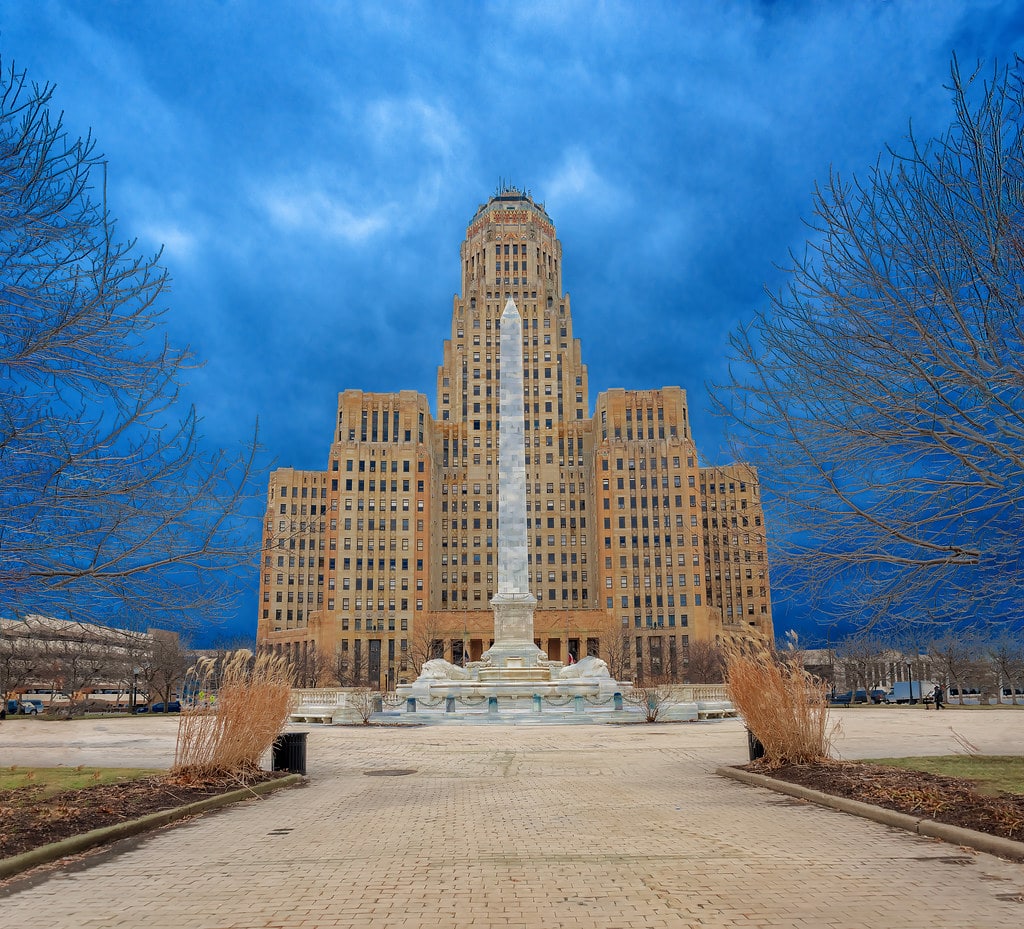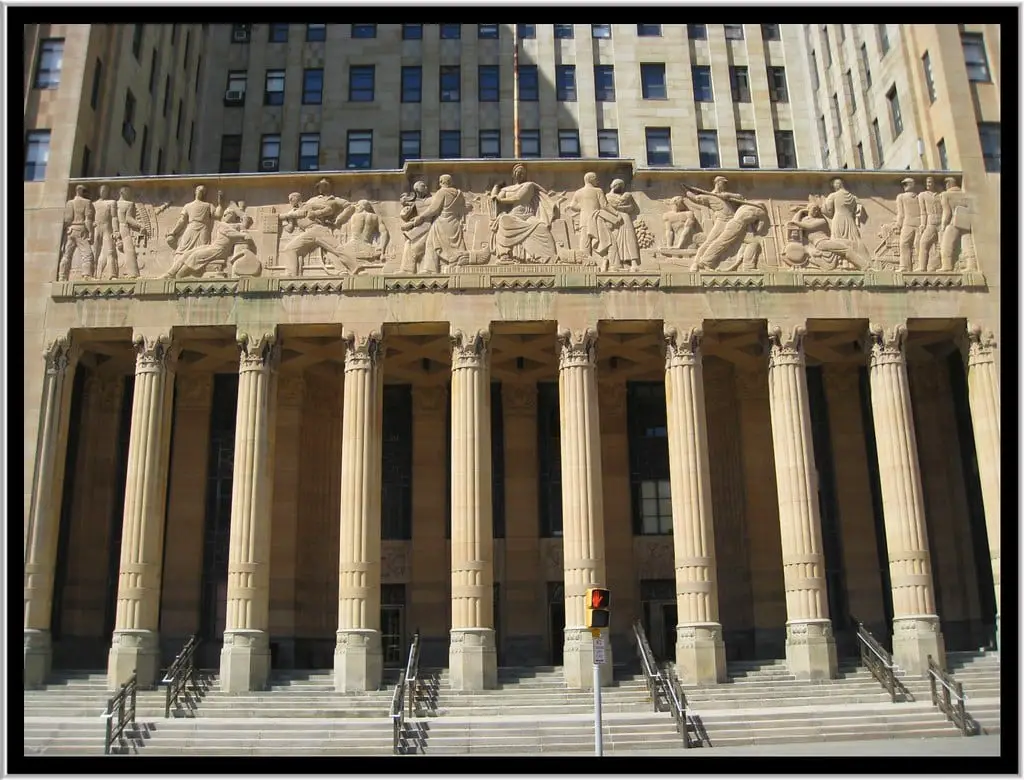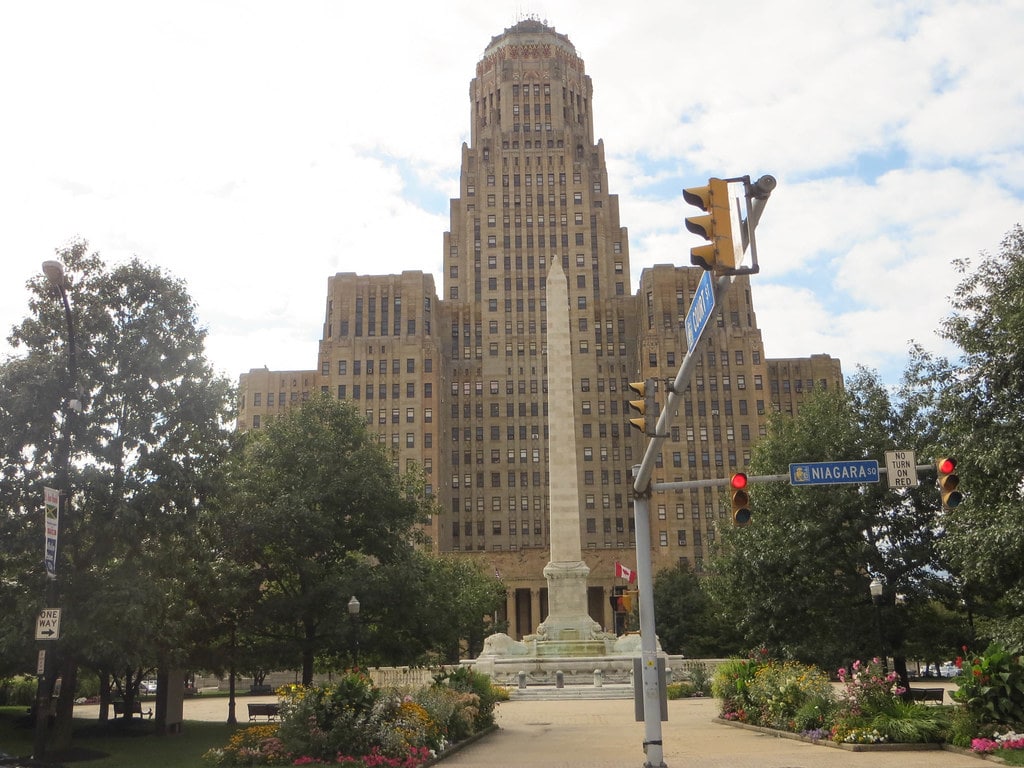The Historical Significance of Buffalo City Hall
Buffalo City Hall is a testament to the city's growth and architectural ambition. Constructed in 1931, this Art Deco masterpiece reflects a period of significant expansion and optimism in Buffalo, New York.
The decision to build such a monumental structure came after recognizing the city's quadrupled population since the previous city hall's construction. It marked a new era for Buffalo, aiming to accommodate its burgeoning administrative needs and make a bold architectural statement.
The design, a collaborative effort by Dietel, Wade & Jones, broke away from traditional forms, embracing the modern Art Deco movement that was sweeping through America.
The building's completion on November 10, 1931, symbolized Buffalo's aspirations and status as a burgeoning industrial power. The choice of location, Niagara Square, aligns with Joseph Ellicott's original city plan, linking the new with Buffalo's historical heartbeat.
Before this grand structure, the city's administrative offices were housed in a building constructed between 1871 and 1875, known as the Old County Hall. As Buffalo evolved, so did its needs. The old building, while significant, could no longer support the city's growth. The move to construct a new city hall was a bold step towards modernization and efficiency, reflecting a city in transformation.
Buffalo City Hall is not just an office building; it's a piece of history, encapsulating the spirit of an era. It stands as a beacon of progress, a monument to the city's past achievements and future aspirations.
As I delve into the architectural marvel of Buffalo City Hall, I'm reminded of the city's resilience and dynamic spirit. It's a cornerstone of Buffalo's civic life, embodying its architectural heritage and ongoing story.
For anyone exploring things to do in Buffalo, New York, visiting City Hall is more than a step back in time; it's an insight into the city's heart and soul.
The building's historical and architectural significance makes it a key landmark for locals and visitors seeking to understand Buffalo's rich cultural tapestry.
Architectural Marvel and Design
I often think about the impact of architecture on a city's character. Buffalo City Hall is a prime example, standing tall with its Art Deco grandeur.
The building's design, spearheaded by the architectural firm Dietel, Wade & Jones, showcases a blend of functionality and aesthetic appeal.
The 32-story structure, completed in 1931, is not just a building; it's a statement. Its towering presence at 398 feet makes it one of the most significant landmarks in Buffalo.
The Art Deco style of City Hall is no accident. It reflects the era's optimism and the city's industrial boom. The design incorporates geometric shapes, sharp lines, and ornamental details, all hallmarks of the movement.
The building's facade, adorned with intricate friezes and sculptures, tells the story of Buffalo's industrial and cultural heritage.
One of the most fascinating aspects of City Hall is its practical design features. The windows, for example, open inward, a clever solution to the challenges of window washing in such a tall building.
This detail might seem small, but it speaks volumes about the era's innovation and attention to practicality.
The building also boasts an original non-powered air-conditioning system, which utilizes the natural winds from Lake Erie. This is a testament to the ingenuity of its designers.
The Heart of Buffalo's Civic Life
City Hall is more than its stone and mortar; it's the epicenter of Buffalo's civic life. It's where the city's decisions happen, from council meetings to mayor's office deliberations. The building is not just for politicians and city employees; it's a space for the community.
The council chambers, public galleries, and observation deck are places where residents can engage with their city's workings or enjoy the view of their city.
The role of City Hall extends beyond governance. It's a symbol of the community's resilience and collective memory. It has witnessed protests, celebrations, and everything in between. These events, big and small, contribute to the ongoing narrative of Buffalo's community.
The building's accessibility to the public is noteworthy. The observation deck, for example, offers panoramic views of the city and beyond, a physical reminder of the city's vastness and potential.
It's a place where one can feel a deep connection to Buffalo, understanding its past while looking out toward its future.
In my view, Buffalo City Hall embodies the spirit of the city. It is a testament to Buffalo's history, challenges, and triumphs.
As a focal point of civic life, it continues to serve as a place of governance, a symbol of community, and a beacon of architectural beauty.
Art and Symbolism in Stone and Steel
When I think about Buffalo City Hall, I can't help but marvel at the art and symbolism embedded in its structure. It's like a history book in stone and steel, each detail a chapter from Buffalo's past.
The Art Deco design extends to the intricate friezes and sculptures adorning the building's exterior.
These aren't just decorations; they're narratives, each telling a story of the city's industrial might, cultural heritage, and community spirit.

The main entrance, for instance, is a gateway to Buffalo's history. The symbolic figures there don't just welcome visitors; they introduce them to the city's past.
From the representation of past generations passing knowledge to Buffalo's youth to depicting the steel industry, each element is a nod to the city's roots and growth.
It's fascinating how the architects Dietel, Wade & Jones, and sculptors like Albert Stewart and Rene Paul Chambellan creatively and enduringly encapsulated Buffalo's essence.
Inside, the symbolism continues. The lobby's murals and statues aren't merely for show; they reflect Buffalo's civic virtues - diligence, service, fidelity - and remind visitors of the city's values and aspirations.
The artwork, from the vibrant murals to the detailed sculptures, is a constant reminder of Buffalo's identity and the collective memory of its people.
Buffalo City Hall in Popular Culture and Folklore
Buffalo City Hall has transcended its role as a mere building; it's become a character in its own right, featuring in tales and shows that reach beyond the city's borders.
I find it fascinating how this architectural marvel has entered popular culture, such as its fictional role as the new White House in the television series Avenue 5.
It's a testament to the building's iconic status and unique design that it can be reimagined in such diverse contexts.
However, City Hall plays a role, not just in fiction. It's woven into the fabric of local folklore, with stories and legends passed down through generations.
One such tale is the urban legend of a fire that supposedly destroyed records in the 19th or 20th century.
Despite being debunked by historians, this story adds to the building's mystique, blending fact with fiction in the collective memory of Buffalo's residents.
These cultural and folkloric narratives add another layer to City Hall's significance. They show how a building can be more than bricks and mortar; it can be a symbol, a muse, and a keeper of stories.
It's fascinating to see how City Hall has become embedded in the city's cultural landscape, not just as a backdrop but as a central figure in Buffalo's ongoing story.

Challenges and Controversies
Like any historic building, Buffalo City Hall has faced its share of challenges and controversies. Over the years, the building has encountered structural issues, a common plight for its age and size structures.
The 1939 discovery of defects due to missing anchors behind the granite facings is a case in point. Water seepage led to significant damage, a stark reminder of the constant battle against time and elements that such landmarks face.
Renovation efforts have been ongoing, with significant updates to maintain the building's grandeur and functionality.
However, these renovations often come with challenges, from funding disputes to debates over historical accuracy versus modern needs.
Balancing the preservation of historical integrity with the demands of a modern municipal building is no small feat.
Moreover, City Hall has not been immune to controversies, often finding itself at the heart of civic debates.
Its role as the epicenter of Buffalo's civic life means that decisions made within its walls can lead to public dissent or celebration.
Yet, these controversies also highlight City Hall's importance as a public forum. In this place, the city's issues are confronted head-on.
The Future of Buffalo City Hall
Looking ahead, Buffalo City Hall's future seems as steadfast as its past. The building continues to serve as a beacon of governance and community pride.
Its historical significance and architectural beauty remain undiminished, promising to inspire future generations.
Considering its role in the Envision Neighborhoods Initiative, the city's plans for the building suggest a commitment to integrating City Hall into Buffalo's broader urban development goals.
This initiative, aimed at revitalizing neighborhoods, underscores the building's continued relevance to the city's future.

Moreover, the potential for adding more floors or reconfiguring interior spaces, as originally designed by John Wade, speaks to the building's inherent adaptability.
This flexibility ensures that City Hall can evolve alongside Buffalo, meeting the city's changing needs while preserving its historical essence.
Buffalo City Hall symbolizes the city's resilience, architectural ambition, and civic spirit. As Buffalo moves forward, it will remain at the heart of its story, a testament to its past achievements and future possibilities.
